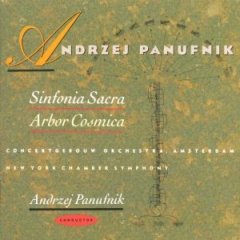Andrzej Panufnik: Sinfonia Sacra - Arbor Cosmica (1990)
Andrzej Panufnik: Sinfonia Sacra - Arbor Cosmica (1990)

1. 3 Visions 10:39
2. Hymn 9:35
3. I. Andante Moderato 3:10 play
4. II. Allegretto 2:36
5. III. Andante Con Moto 4:24
6. IV. Prestissimo Possibile 1:47
7. V. Moderato 4:32
8. VI. Lento-Moderato-Vivacissimo 2:22
9. VII. Larghetto 4:39
10.VIII. Molto Allegro 1:50 play
11. IX. Andantino 3:33
12. X. Molto Vivace 2:17
13.Arbor Cosmica: Xi. Adagietto 6:01
14. XII. Presto 1:26
1 – 2 Sinfonia Sacra
Concertgebow Orchestra, Amsterdam
Andrzej Panufnik – conductor
3 – 14 Arbor Cosmica
New York Chamber Symphony
Andrzej Panufnik – conductor
I'm not all that familiar with the output of Andrej Panufnik, although I've heard recently and reviewed a number of his Symphonies, including Sinfonia Elegiaca (#2), Sinfonia Votiva (#8), Sinfonia di Sfere (#5) and Mistica (#6). I tend to categorize him among the "mildly modern" composers from the second half of the 20th Century, not belonging to the avant-garde, and certainly less advanced in his musical language and less original than his two compatriots Penderecki (the composer of the 1960s and early 1970s at least) and Lutoslawski, but not either a backward-looking neo-Romantic. I've also found that he got better as he aged. Sinfonia Elegiaca (1957) I found rather clichéd and bombastic, striving a little too hard for effect and using to that end very predictable musical resources (see my review of Andrzej Panufnik: Nocturn / Rhapsody / Symphony 2). On the other hand Symphonies 5 & 6 (1975, 1977) are two superb compositions, organizing a highly efficient architecture of tension and repose, couched in a highly dramatic but accessible language and full of ear-catching orchestral touches (Panufnik: Sinfonia Mistica, Sinfonia di Sfere). Likewise the 8th (1981) is is a haunting work, in the austere sparseness and delicacy of its instrumentation and stylistic independence of its language (Symphony 8 / Concerto for Orchestra or Andrzej Panufnik: Sinfonia Votiva (Symphony No. 8) / Roger Sessions: Concerto for Orchestra - Boston Symphony Orchestra).
Sinfonia Sacra is Panufnik's 3rd Symphony and dates from 1963. It is a tribute to Poland's millennium "of Christianity and Statehood". It is apparently its composer's most popular symphony, if the number of recordings is to serve as a pointer: listed on this site are recent recordings by Gerard Schwarz (Andrzej Panufnik: Symphony No. 10 (World Premier Recording) / Autumn Music / Heroic Overture / Sinfonia Sacra - Seattle Symphony), John Storgards (Panufnik: Heroic Overture; Sinfonia de Sfere; Landscape; Sinfonia Sacra [Hybrid SACD]) and even another, earlier composer-conducted one, with the Monte Carlo Symphony Orchestra, initially on Unicorn Andrzej Panufnik: Sinfonia Sacra / Concerto Festivo / Landscape / Katyn Epitaph / Concertino - Monte Carlo Opera Orchestra / London Symphony Orchestra / Andrzej Panufnik, but now best found on an EMI "British Composers" UK release, paired with Sinfonia Rustica (1st Symphony) and Sinfonia Concertante (4th Symphony), not listed on this site but available as ASIN B000E5L84S on its European sister companies.
Still, it took me a few hearings to warm up to it. As with other Panufnik symphonies, I found its architecture somewhat simplistic and its musical resources rather unsubtle, going a little too much for immediate effect not to elicit some resistance. The first movement is made of three strongly contrasted "visions": a grandiose brass fanfare evoking some biblical call to arms, a serene, brooding cantilena intoned from hushed strings, and a percussion-introduced, turbulent, violently agitated conclusion symbolising, no doubt, the calamities that beset Poland throughout its History. The second movement is an extended "hymn", an elaboration of the Bogurodzica, the oldest Gergorian hymn in Polish language: hushed strings, high-pitched harmonics, mystic atmosphere, whiffs of the monastery heard from a distance, rising to a climax of triumphant and lyrical intensity. It may strive for predictable effect, but ultimately the effect is hard to resist.
But the real masterpiece here is Arbor Cosmica (Cosmic Tree). Composed in 1983, i is a suite of 12 pieces, scored for 12 strings. That they are evocation of trees, all based on a three-note chord mapped like a tree and all symbolically elaborated so that a melody in the highest violin registers will flow down to the bass while the accompaniment will "photosynthesise up from the lowest range (the roots) to the upper strings", is ultimately anecdotal. What counts is the mesmerizing wealth of invention, the constant ear-catching and never-predictable twists and turns of orchestral colors, the variety of moods conjured, the breathtaking dramatic impact. Arbor Cosmica must be counted among the 20th-century masterpieces for string ensemble.
The recordings were made in 1987 and 1988 and the readings, under the conductor's stewardship and with major ensembles (no less than the Amsterdam Concertgebouw in Sinfonia Sacra) are, needless to say, authoritative. –Discophage (France)
download: uploaded yandex 4shared mediafire solidfiles mega filecloudio nornar ziddu
Zmieniony (Sobota, 08 Marzec 2014 20:38)








